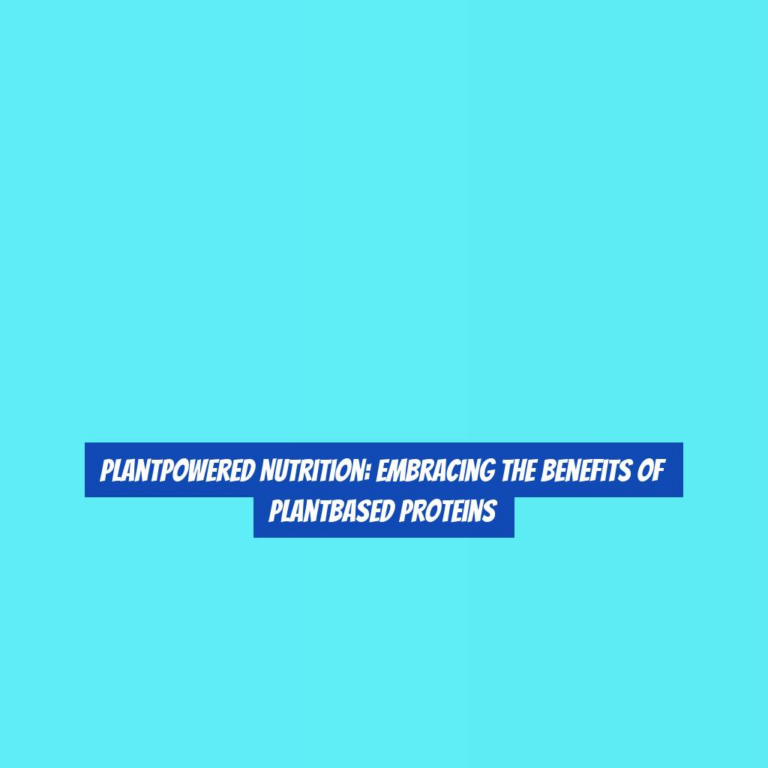Green Protein: Harnessing the Nutritional Power of PlantBased Proteins
Have you ever wondered if plant-based proteins can truly provide the same nutritional benefits as animal-based proteins?
The growing interest in green protein and its potential health advantages has sparked a wave of research and discussion.
As you explore the world of plant-based proteins, you might be surprised by the wealth of options and the compelling evidence supporting their nutritional power.
Whether youG??re a committed vegetarian or simply looking to diversify your protein sources, understanding the benefits and incorporating green protein into your diet could be a game-changer for your overall health and well-being.
Benefits of Plant-Based Proteins
Harnessing the power of plant-based proteins can significantly improve overall health and well-being. By incorporating plant-based proteins into your diet, you can reap a multitude of benefits.
Firstly, these proteins are typically lower in saturated fats and cholesterol compared to animal-based proteins, which can help lower your risk of heart disease and improve cardiovascular health. Additionally, plant-based proteins are often rich in fiber, vitamins, and minerals, which are essential for a well-functioning digestive system and overall vitality.
Moreover, choosing plant-based proteins can also have a positive impact on the environment. The production of plant-based proteins generally requires fewer natural resources and produces fewer greenhouse gas emissions compared to animal-based proteins, making it a more sustainable and eco-friendly choice.
Furthermore, incorporating a variety of plant-based proteins into your diet can also help with weight management and provide long-lasting energy throughout the day. With the diverse range of plant-based protein sources available, including legumes, nuts, seeds, and grains, itG??s easy to find delicious and nutritious options to support your overall health and well-being.
Top Sources of Green Protein
Looking for the top sources of green protein to add to your diet? Incorporating plant-based proteins into your meals can provide a wealth of nutrients and health benefits. Here are some of the best sources of green protein to consider:
-
Lentils: Packed with protein and fiber, lentils are a versatile legume that can be used in soups, salads, and stews.
-
Quinoa: This ancient grain is a complete protein, containing all nine essential amino acids, making it an excellent addition to your diet.
-
Chickpeas: Whether roasted for a crunchy snack or blended into creamy hummus, chickpeas are a fantastic source of protein and can be used in a variety of dishes.
-
Spinach: This leafy green isnG??t only rich in iron and vitamins, but it also contains a good amount of protein, making it a valuable addition to salads and smoothies.
-
Tofu: Made from soybeans, tofu is a versatile protein source that can be used in stir-fries, curries, and as a meat substitute in various recipes.
Incorporating these top sources of green protein into your diet can help you meet your nutritional needs while enjoying a diverse range of delicious and healthy plant-based foods.
Nutritional Value of Green Protein
To understand the nutritional value of green protein, itG??s essential to recognize the diverse array of vitamins, minerals, and amino acids found in plant-based sources.
Plant proteins such as lentils, chickpeas, quinoa, and tofu arenG??t only rich in protein but also provide essential nutrients. For instance, theyG??re packed with vitamins like folate, vitamin C, and vitamin K. These vitamins contribute to overall health, supporting functions such as cell growth, immune system strength, and blood clotting.
Additionally, green proteins offer minerals such as iron, calcium, and potassium, which are crucial for maintaining healthy bones, muscle function, and blood pressure regulation.
Moreover, plant-based proteins contain all nine essential amino acids that the body canG??t produce on its own. These amino acids are the building blocks of protein and play a vital role in various bodily functions, including muscle repair and hormone regulation.
Incorporating Green Protein Into Your Diet
Incorporating green protein into your diet can be achieved by experimenting with a variety of plant-based protein sources in your meals and snacks. Here are some simple yet effective ways to incorporate green protein into your diet:
-
Try Meat Alternatives: Experiment with meat alternatives such as tofu, tempeh, seitan, or plant-based burger patties. These options can be used in stir-fries, sandwiches, or salads for a protein-packed meal.
-
Include Legumes: Incorporate legumes such as lentils, chickpeas, black beans, and edamame into your diet. These versatile legumes can be added to soups, stews, curries, or used to make delicious veggie burgers.
-
Snack on Nuts and Seeds: Snack on nuts and seeds like almonds, pumpkin seeds, chia seeds, or hemp seeds. They can be eaten on their own, added to yogurt, or used as toppings for salads and smoothie bowls.
-
Opt for Whole Grains: Choose whole grains like quinoa, brown rice, farro, or barley as a source of protein in your meals. These grains can be used as a base for bowls, added to soups, or enjoyed as a side dish.
-
Blend in Protein Powders: Consider using plant-based protein powders such as pea protein, hemp protein, or brown rice protein in smoothies, baked goods, or homemade energy bars for an extra protein boost.
Green Protein Recipes and Meal Ideas
Consider experimenting with these green protein recipes and meal ideas to further enhance your plant-based protein intake and elevate your culinary experience.
Start your day with a nutrient-packed green smoothie by blending spinach, kale, banana, and a scoop of plant-based protein powder.
For a satisfying lunch, try a quinoa salad with edamame, avocado, and a drizzle of lemon-tahini dressing. Another option is a hearty lentil and vegetable stew, perfect for a cozy dinner.
Tofu stir-fry with a variety of colorful vegetables is also a delicious way to incorporate plant-based protein into your meals.
If youG??re in the mood for a snack, roasted chickpeas seasoned with your favorite spices make for a crunchy and protein-rich treat. Additionally, consider baking a batch of spinach and feta chickpea muffins for a protein-packed snack on the go.
These recipes not only provide an excellent source of plant-based protein but also offer a diverse range of flavors and textures to keep your meals exciting and satisfying.
Conclusion
So, whether youG??re looking to improve your health, reduce your environmental impact, or simply try something new, green protein is a fantastic option.
With its numerous benefits, variety of sources, and delicious recipes, incorporating plant-based proteins into your diet has never been easier.
So go ahead, give green protein a try and see the positive impact it can have on your health and the planet.






